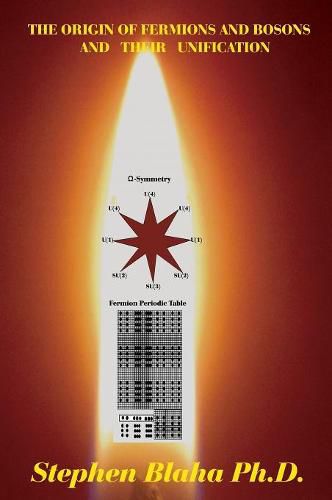Readings Newsletter
Become a Readings Member to make your shopping experience even easier.
Sign in or sign up for free!
You’re not far away from qualifying for FREE standard shipping within Australia
You’ve qualified for FREE standard shipping within Australia
The cart is loading…






This book takes the Complex Lorentz group as our starting point and derives the four types (species) of fermions directly. It then proceeds to show the interactions of the Standard Model SU(3)xSU(2)xU(1) follow directly from Complex Lorentz group geometry. The addition of Dark matter leads to an SU(3)xSU(2)xU(1)xSU(2)xU(1) symmetry if Dark matter is included in an Extended Standard Model.
Then noting that there are particle number quanta: Baryon number, Lepton number, and their Dark equivalents it develops the U(4) Generation group that generates four generations of each species of fermion (although only three generations are known at present). The existence of four generations of each species then leads in turn to another U(4) group - the Layer group - that gives us a Periodic Table of Fermions with three additional replicas (with changes) of the layer of four generations, with which we are familiar. In total it reveals 192 different fermions - 128 quarks and 64 leptons.
Having discovered the riches of the Complex Lorentz group, and realizing that it could only exist in our slightly curved space-time, it see that Complex General Relativity and its coordinate systems must follow. It would be illogical if General Relativity were real-valued and flat space-time complex-valued. So it proceeds to consider Complex General Relativity and discover that each Complex General Coordinate Transformations can be factored into a real General Coordinate transformation and a complex coordinate transformation. This leads to another U(4) group it calls the General Relativistic Reality group. The interactions associated with this group are part of the set of interactions experienced by fermions.
Taken altogether it creates a unified theory of an Extended Standard Model and General Relativity with the symmetry SU(3xSU(2)xU(1)xSU(2)xU(1)xU(4)xU(4)xU(4) plus real-valued General Coordinate transformations. Given this menagerie of interactions it develops a formalism for the ‘rotation of interactions’ called -symmetry, which introduces a new gauge field interaction between all 192 fermions, and their interactions. This symmetry completes the unification process. For if one can rotate things into each other, they are in a sense the same (or related). It concludes by showing that the gravity potential found at solar system distances, at galactic distances, and at inter-galactic distances follow from our theory. It also shows that the theory yields a linear quark potential and the Charmonium potential. Lastly it shows the theory may explain the missing proton spin puzzle, and also the difference in the proton radius of the hydrogen and muonic hydrogen atoms.
$9.00 standard shipping within Australia
FREE standard shipping within Australia for orders over $100.00
Express & International shipping calculated at checkout
Stock availability can be subject to change without notice. We recommend calling the shop or contacting our online team to check availability of low stock items. Please see our Shopping Online page for more details.
This book takes the Complex Lorentz group as our starting point and derives the four types (species) of fermions directly. It then proceeds to show the interactions of the Standard Model SU(3)xSU(2)xU(1) follow directly from Complex Lorentz group geometry. The addition of Dark matter leads to an SU(3)xSU(2)xU(1)xSU(2)xU(1) symmetry if Dark matter is included in an Extended Standard Model.
Then noting that there are particle number quanta: Baryon number, Lepton number, and their Dark equivalents it develops the U(4) Generation group that generates four generations of each species of fermion (although only three generations are known at present). The existence of four generations of each species then leads in turn to another U(4) group - the Layer group - that gives us a Periodic Table of Fermions with three additional replicas (with changes) of the layer of four generations, with which we are familiar. In total it reveals 192 different fermions - 128 quarks and 64 leptons.
Having discovered the riches of the Complex Lorentz group, and realizing that it could only exist in our slightly curved space-time, it see that Complex General Relativity and its coordinate systems must follow. It would be illogical if General Relativity were real-valued and flat space-time complex-valued. So it proceeds to consider Complex General Relativity and discover that each Complex General Coordinate Transformations can be factored into a real General Coordinate transformation and a complex coordinate transformation. This leads to another U(4) group it calls the General Relativistic Reality group. The interactions associated with this group are part of the set of interactions experienced by fermions.
Taken altogether it creates a unified theory of an Extended Standard Model and General Relativity with the symmetry SU(3xSU(2)xU(1)xSU(2)xU(1)xU(4)xU(4)xU(4) plus real-valued General Coordinate transformations. Given this menagerie of interactions it develops a formalism for the ‘rotation of interactions’ called -symmetry, which introduces a new gauge field interaction between all 192 fermions, and their interactions. This symmetry completes the unification process. For if one can rotate things into each other, they are in a sense the same (or related). It concludes by showing that the gravity potential found at solar system distances, at galactic distances, and at inter-galactic distances follow from our theory. It also shows that the theory yields a linear quark potential and the Charmonium potential. Lastly it shows the theory may explain the missing proton spin puzzle, and also the difference in the proton radius of the hydrogen and muonic hydrogen atoms.